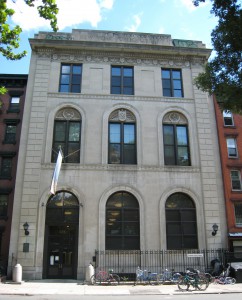Landmarks50: The New York Public Library Tompkins Square Branch

As part of our continuing Landmarks50 celebration, and in honor of Stanford White’s birthday today (he would be a mere 162 years old), we are looking at the New York Public Library Tompkins Square Branch designed by his firm, McKim Mead & White, and completed in 1904. Located at 331 East 10th Street north of Tompkins Square Park, it was designated as a New York City Landmark in 1999 and is part of the East 10th Street Historic District. The Thompkins Branch of NYPL has played a prominent role in the neighborhood since it opened its doors.
During the nineteenth century, few libraries in New York City were open to the public. Further, the City trailed behind other metropolises in public library support. Several institutions were founded to address this social concern. The New York Free Circulating Library was founded in 1878 to provide education and self-help to the poor, funded in part by public funds and in part by support of benefactors such as Andrew Carnegie, J.P. Morgan and Cornelius Vanderbilt. The Aguilar Free Library Society was started in 1886 to foster the free circulation of “carefully selected literature” with branches in areas “where the Jewish population was dense.” In 1901 these two institutions merged with the New York Public Library (established in 1895) spurred by the promise of a large grant from Andrew Carnegie.

Andrew Carnegie began donating to libraries in 1881. More than 2,500 Carnegie libraries were built around the world with over 1,680 in the United States. His altruism was based on his philosophy that the wealthy should live modestly and, while still living, give away their funds for the good of humanity; Carnegie gave away about 90% of his wealth by the time he died in 1911. He donated $5.2 million to New York City to build a system of branch libraries which resulted in sixty-seven branches throughout the five boroughs.

An architect’s committee was formed to provide the designs for the branch libraries. This committee included Charles McKim of McKim, Mead & White, John M. Carrere of Carrere & Hastings, and Walter Cook of Babb Cook & Willard. It was agreed by the committee that the branches would be recognizable by being uniform in materials, size, plan, and scale and that the different site requirements would foster variety. Central locations in densely populated neighborhoods were chosen for the branches. The East Village was one of the most densely populated areas in the world at this time.

The Tompkins Square branch was designed along the same principles applied to other New York City Library branch buildings. It is a distinct structure which stands out from its neighboring structures. Its style is a simplified Beaux-Arts and it is clad in limestone with a classical vocabulary. It is sited mid-block and vertically oriented. Three stories in height and three bays wide, it features large arched and rectangular windows to allow for a copious amount of light on the interior. The front façade is slightly recessed from the property line and is capped by a prominent denticulated cornice. The swag-and-shield frieze is set above rusticated pilasters and carved stone capitals.
Today the library continues to serve the community not only in its educational mission but also as an architectural fixture to the area. For more information on the structure and its history, click HERE for the Landmark Designation Report.
